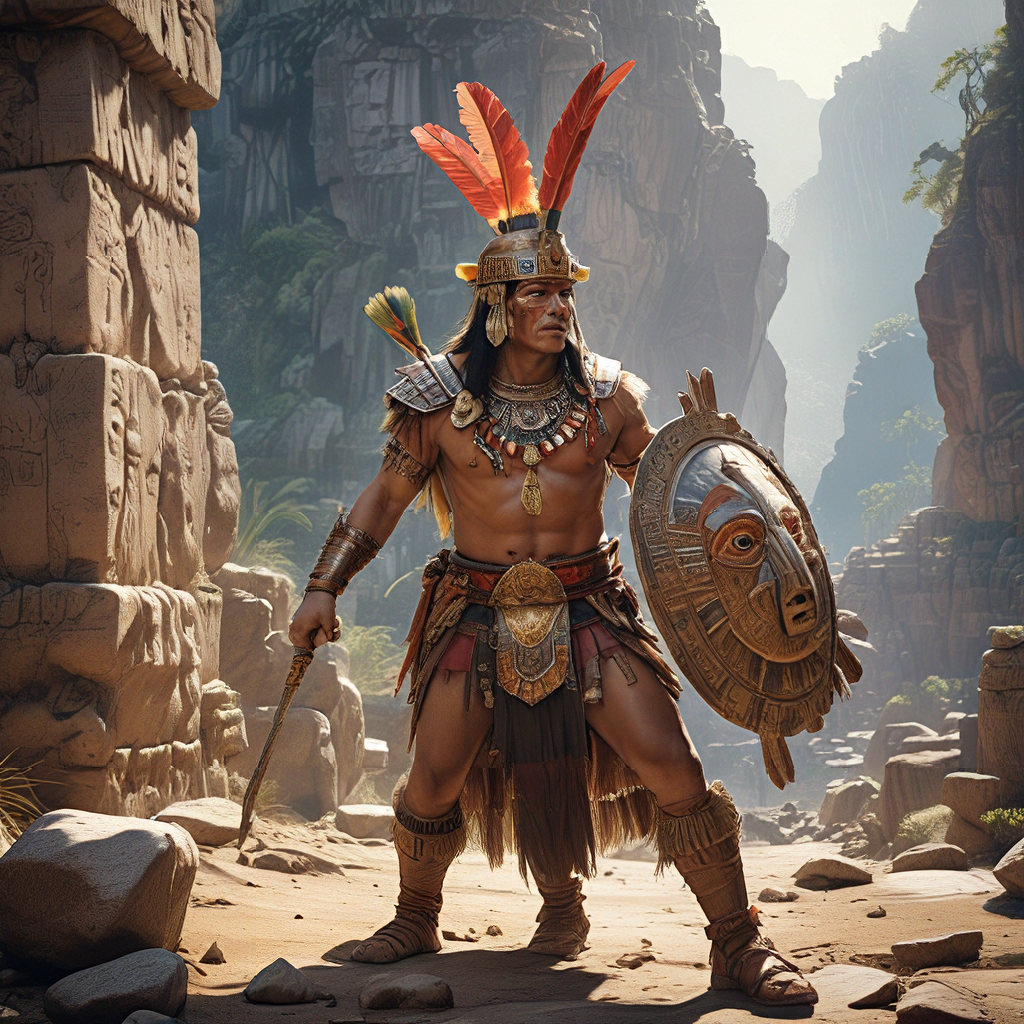Incan Mythological Warfare: Strategies of the Ancients
The Inca Empire, stretching across the Andes Mountains in South America, was a powerful civilization known for its intricate social structures and impressive architectural feats. However, beneath the surface of this seemingly advanced society lay a rich tapestry of myth and legend, deeply intertwined with the very fabric of Incan warfare. These myths provided a framework for understanding the world, their place in it, and the nature of conflict itself.
1. The Inca Cosmology: A Tapestry of Gods and Battles
Incan mythology is a vibrant world of powerful deities, epic battles, and intricate cosmology. The Inca believed that their world was created by a supreme being, Viracocha, and governed by a complex network of gods and goddesses. This pantheon of deities played a crucial role in shaping Incan beliefs about war, strategy, and the very meaning of life itself. The Inca saw their struggles not just as earthly battles, but as reflections of the cosmic conflicts that had shaped the universe itself.
2. Viracocha: The Creator and the Cosmic War
Viracocha, the supreme creator god, was central to the Incan worldview. He was a powerful figure who emerged from Lake Titicaca, the sacred heart of the Incan world, to create the Earth, the Sun, the Moon, and humankind. According to Incan myths, Viracocha was also a warrior god who fought against other gods in a cosmic battle to establish order and harmony. This cosmic war, a battle for supremacy and control, serves as a central theme in Incan mythology, influencing their understanding of earthly warfare.
3. Inti and the Sun’s Army: A Celestial Struggle for Power
Inti, the Sun God, was another powerful figure in Incan mythology. He was revered as the source of life and prosperity, and his army of celestial warriors fought alongside the Inca in battles for conquest and expansion. Inti's power was reflected in the Inca's reverence for the sun, their use of solar calendars, and their belief that military success was often attributed to the favor of the sun god. His battles against the forces of darkness and chaos, found in Incan myths, served as inspiration for the Inca's own military campaigns.
4. Pachamama: The Earth Mother and the War for Resources
Pachamama, the Earth Mother, was revered by the Inca as the source of all sustenance and resources. She was a powerful deity who held dominion over the land, agriculture, and the bounty of nature. In Incan myths, Pachamama was involved in fierce battles with other deities for control over the planet's resources. These struggles for control over the earth's bounty mirrored the Inca's own conflicts over territory and resources, highlighting the importance of Pachamama in their understanding of war and conquests.
5. The Role of Shamans and Ritual Warfare
Shamans, known as "yachay" in Incan society, played a crucial role in Incan warfare. They were believed to possess supernatural powers and were responsible for communicating with the spirit world, performing rituals, and influencing the outcome of battles. The Inca saw warfare as a spiritual endeavor, and the role of shamans was essential for ensuring victory through divine intervention. This meant incorporating a strong element of ritual warfare in their strategies, where rituals and ceremonies were performed before battles to appease the gods and secure their blessings for success.
6. Strategies of Deception and Psychological Warfare
The Inca weren't just about brute force. They were masters of psychological warfare, using deception and intimidation to gain an advantage. Myths about powerful gods and fierce warriors instilled fear and respect in their enemies.
Incan myths sometimes portrayed their leaders as divine descendants, giving them an aura of invincibility. These stories painted a picture of a people chosen by the gods, making enemies hesitant to challenge them. The Inca also used propaganda to spread stories of their strength and victories, weakening the morale of their opponents.
In addition to psychological tactics, the Inca were also skilled at strategic deception. They might use camouflage to ambush enemies, or send false messages to confuse them. These tactics, inspired by the cunning and tricks of the gods in their myths, helped them secure victory in many battles.
7. The Mythical Origins of Incan Weapons and Armor
Incan weapons, like the macana (a club), the atlatl (a spear-thrower), and the slingshot, were not just tools of war but also sacred objects, imbued with the power of the gods. Myths surrounding these weapons often narrated their creation by divine beings, lending them a mystical significance.
For example, the slingshot, an incredibly effective weapon in Incan warfare, was said to have been given to them by the god Viracocha himself. This myth instilled confidence in the Inca warriors who wielded this weapon, believing they were carrying the blessings of the gods. Similarly, the macana, a fearsome club, was often believed to be crafted from the bones of mythical beasts, further enhancing its symbolic power.
The armor worn by Incan warriors, often made of leather, cotton, or metal plates, also had mythical significance. It was believed to protect them from the arrows and weapons of their enemies, and to be imbued with the spirits of powerful ancestors. This combination of practical design and mythical association enhanced the effectiveness of Incan weapons and armor, both physically and psychologically.
8. The Significance of Sacrifice in Incan Warfare
Sacrifice played a central role in Incan society and was deeply intertwined with their mythology and warfare. The Inca believed that sacrifices appeased the gods, ensuring victory in battle and good fortune for their people. These sacrifices were often bloody and elaborate, involving the offering of animals, plants, and even human life.
The Inca believed that the blood of sacrifices was a powerful offering to the gods, particularly Inti, the Sun God. By offering these sacrifices, the Inca believed they were establishing a sacred bond with the gods, securing their favor and protection in war.
9. The Influence of Myth on Incan Military Tactics
Incan military tactics were heavily influenced by their myths and beliefs. They believed in the power of the gods to guide their armies, and they used this belief to inspire their soldiers and strategize their campaigns.
For example, the Inca incorporated elements from their mythology into their formations. They might use the image of Inti, the Sun God, as a rallying point for their warriors, or mimic the movements of celestial bodies in their formations, believing these tactics would bring them divine favor. This blend of practicality and myth informed their military tactics, creating a unique brand of warfare that was both effective and spiritually charged.
10. The Legacy of Incan Mythological Warfare: Lessons for Modern Understanding
The legacy of Incan mythological warfare offers valuable insights into the human experience of conflict and the power of belief systems. It reveals that even in the face of physical challenges, the human spirit often finds solace in myths, stories, and rituals.
The Incan example reminds us that warfare is not always simply a matter of physical strength and strategy. It is often intertwined with a web of cultural beliefs, religious practices, and mythical narratives that shape the actions, motivations, and outcomes of conflict.
By understanding the influence of myth on Incan warfare, we can gain valuable insights into the complex interplay between culture, belief, and military strategy. This understanding can help us interpret historical events, predict future conflicts, and foster a more nuanced understanding of human behavior in the face of conflict.
FAQ
Q: What is the significance of Viracocha in Incan mythology?
A: Viracocha is the supreme creator god in Incan mythology. He is responsible for creating the Earth, the Sun, the Moon, and humankind. Viracocha's power is reflected in the Incan worldview and their understanding of conflict.
Q: What is the role of Inti in Incan warfare?
A: Inti, the Sun God, is revered as the source of life and prosperity in Incan mythology. The Inca believed that Inti's favor was crucial for victory in battle. They often sought his blessings through rituals and sacrifices.
Q: What are some examples of Incan weapons with mythical origins?
A: Incan weapons like the macana, the atlatl, and the slingshot were associated with divine beings. They were believed to be imbued with supernatural power, making them particularly effective in battle.
Q: How did the Inca use psychological warfare?
A: The Inca used powerful myths to instill fear and respect in their enemies. They also practiced deception and propaganda to gain an advantage in battle.
Q: What is the significance of sacrifice in Incan warfare?
A: The Inca believed that sacrifices appeased the gods, securing their favor and ensuring victory in battle. These sacrifices were often bloody and involved offering animals, plants, and even human life.




